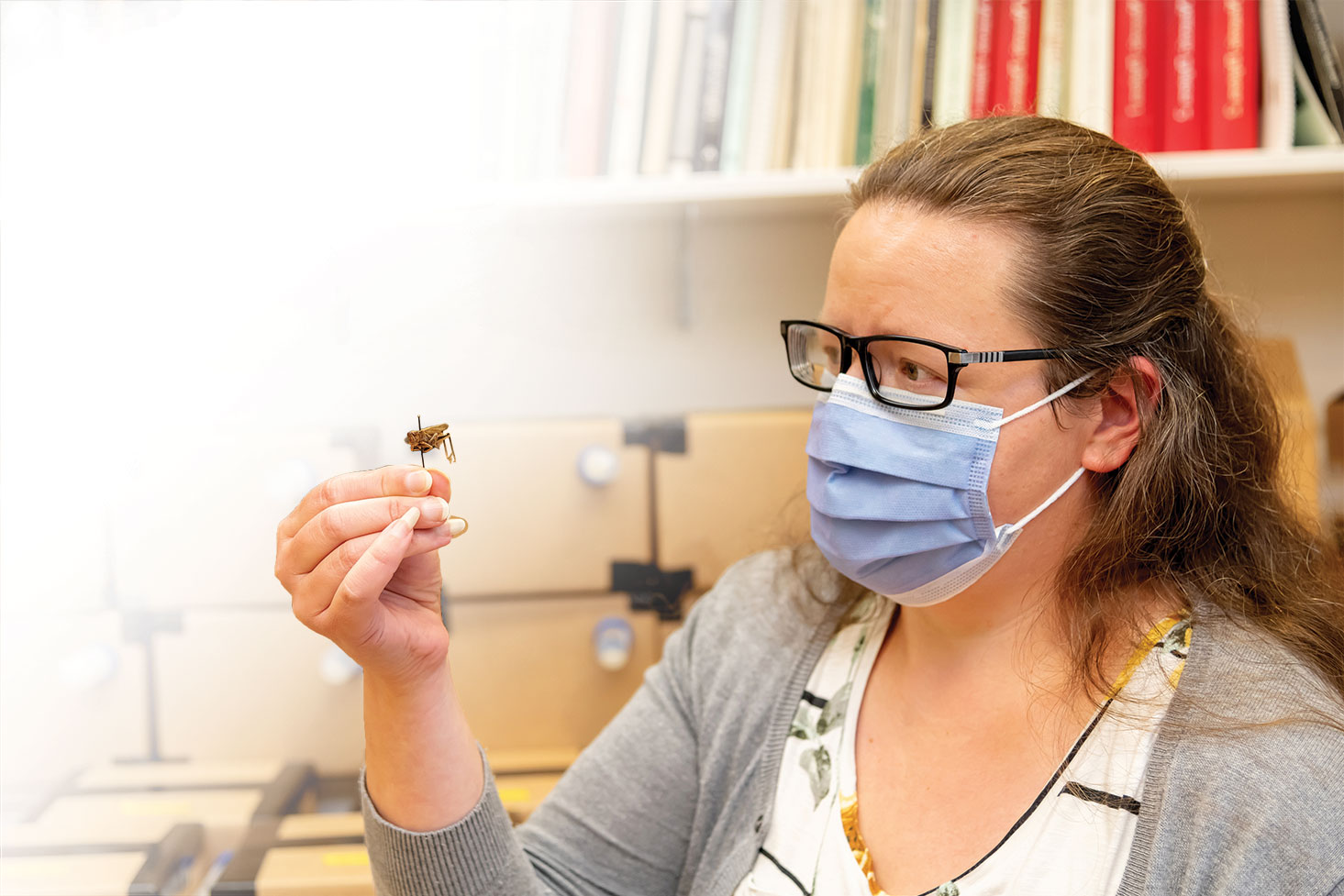Saskatchewan Bulletin
Prairie Pest Monitoring Network collaborates on insect surveillance

Since the mid-1990s, the Prairie Pest Monitoring Network (PPMN) has developed protocols and conducted insect population monitoring for field crop pests in Alberta, Saskatchewan, Manitoba and the Peace River region of British Columbia.
SaskCanola currently co-funds the PPMN with Agriculture and Agri-Food Canada (AAFC) and other commodity organizations in the Prairie provinces as part of the Western Grains Research Foundation-led Integrated Crop Agronomy Cluster.
The PPMN provides its subscribers with free weekly updates by email during the growing season (including an all-important weather synopsis). In this way, timely data gets to stakeholders when insect pests pose the biggest threat to crop yield. Non-subscribers can find the same information online at prairiepest.ca.
Entomologist Meghan Vankosky is co-lead of the PPMN with Jennifer Otani and she is based in Saskatoon. Otani works out of the AAFC Beaverlodge Research Farm in northern Alberta.
Users of the pest monitoring information and risk maps include farmers, agronomists, industry members and policymakers. “Our audience is every stakeholder in the agricultural value chain and goes way beyond other entomologists and academics,” says Vankosky.
In terms of canola crop pests, the PPMN focuses on monitoring cabbage seedpod weevil (an invasive species), diamondback moth, Bertha armyworm and grasshoppers. Diamondback moth are notable for their pesticide-resistance and migratory patterns.
The pluses of a collaborative monitoring program for farmers, agronomists and others involved in pest management include detecting invasive insects that may become a problem and providing other resources. This includes scouting protocols that farmers can use to make pest management decisions.
Overall, the PPMN emphasizes the importance of data collection and monitoring to understand trends that will help direct future research, as well as ensuring farmers are able to manage those trends in their fields.
The PPMN collects annual data and compiles it into distribution maps, and in some cases, forecast maps for the next growing season. Maps are available for canola pests including Bertha armyworm, cabbage seedpod weevil, diamondback moth and grasshoppers. Scouting guides and monitoring protocols are also available for these insects.
Established monitoring protocols include pheromone traps (a type of insect trap that uses pheromones to lure specific species of insects) for Bertha armyworm moth and diamondback moth. “We count on volunteers to host the pheromone traps and report weekly trap catch. Volunteers get real-time information about risk in their fields and provide data that contributes to maps communicating regional risk for the benefit of their neighbours. Volunteers help us to provide timely identification of emerging insect threats across the Prairies,” says Vankosky.
The PPMN provides all necessary supplies at no cost to volunteers. All pest monitoring activities are conducted following provincial biosecurity guidelines.
The PPMN relies on volunteers to grant access to private property for insect sampling. In Saskatchewan, landowners can visit the Saskatchewan Ministry of Agriculture website to sign up to participate in insect, weed and plant pathogen monitoring. More information can be found under Pest Monitoring at www.saskatchewan.ca.
Another aim of the PPMN is to highlight the importance of natural enemies of crop pests. Concludes Vankosky, “the PPMN is highly collaborative on the federal, provincial and academic levels. We hope the information that we provide helps growers make the best possible decisions for their crops. It’s a bit of a cliché, but knowledge is power for making in-season and between season decisions.”
To find out more about the PPMN, and become a subscriber, go to prairiepest.ca
Mark your calendars for SaskCanola’s AGM
SaskCanola’s Annual General Meeting (AGM) is scheduled for Tuesday, January 10, 2023 at 1:30 PM at Prairieland Park in Saskatoon, in conjunction with other crop commissions in the province.
 The purpose of the AGM is to review audited financials and activities from the previous year, including research investments, policy and advocacy initiatives, and grower programs. To help growers plan for the 2023 growing season, market analyst Chuck Penner will present his insights on the state of commodity markets.
The purpose of the AGM is to review audited financials and activities from the previous year, including research investments, policy and advocacy initiatives, and grower programs. To help growers plan for the 2023 growing season, market analyst Chuck Penner will present his insights on the state of commodity markets.
Registered canola producers are eligible to vote on motions and resolutions. Registered canola producers are those who have grown and sold canola in Saskatchewan in the last two years and have not requested a refund in the previous year.
Anyone interested in bringing forward a resolution to the AGM is encouraged to reach out to the SaskCanola office by phone at 306-975-0262 or by email at info@saskcanola.com.
Find out more AGM information at www.saskcrops.com
SaskCanola’s Board Election – What’s next

2022 is an election year for SaskCanola and the nomination process is well underway to fill four positions on our Board of Directors. SaskCanola is governed by eight farmer directors who are elected by levy payers to guide the Commission and help grow producer prosperity.
All levy-paying producers of Saskatchewan-grown canola are eligible to vote in SaskCanola’s board election. If an election is taking place, producers will receive a letter in November that includes a unique voter number. Biographies for each candidate will also be made available at saskcanola.com.
Visit canolavote.com to cast your vote before December 1, 2022. Or, if you wish, you can request a paper ballot and vote by mail.
New directors will begin their four-year terms at SaskCanola’s Annual General Meeting on January 10, 2023. SaskCanola is governed by canola farmers so make sure your voice is heard and vote!
Here are the key dates and actions taking place over the next few months:
CALL FOR NOMINATIONS CLOSES
Friday, Oct. 14 at NOON
If there are five or more nominees, there will be an election.
VOTING PERIOD OPENS
Monday, Nov. 14, 2022
VOTING PERIOD CLOSES
Thursday, Dec. 1, 2022 at NOON
ELECTION RESULTS ANNOUNCED
Friday, Dec. 2, 2022
ANNUAL GENERAL MEETING
Tuesday, Jan. 10, 2023





